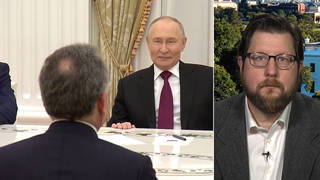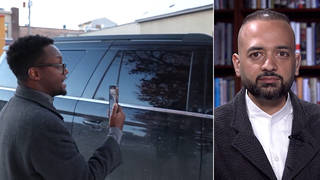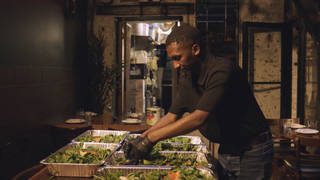
Guests
- Juan GonzálezDemocracy Now! co-host reporting from Scranton, Pennsylvania.
It’s Election Day, and voters are heading to the polls across the country in what election officials are expecting to be record turnout numbers. Pennsylvania is one of the key battleground states in the presidential race. We go to the town of Scranton to get a report from Democracy Now! co-host Juan Gonzalez, where he is on assignment for the New York Daily News. [includes rush transcript]
Transcript
AMY GOODMAN: After an epic campaign that marked the longest and most expensive presidential race in US history, voters are heading to the polls today in what election officials are expecting to be record turnout numbers.
Democratic nominee Barack Obama is leading Republican John McCain in every national poll. One of the key battleground states in the race is Pennsylvania. Democracy Now! co-host Juan Gonzalez is on assignment for the New York Daily News in Scranton, Pennsylvania.
Welcome to Democracy Now!, Juan.
JUAN GONZALEZ: How are you, Amy?
AMY GOODMAN: It’s good to have you with us, at least on the telephone. Talk about what’s happening in this key state today.
JUAN GONZALEZ: Yeah, well, the polls in Scranton opened at 7:00 a.m., and in one polling place here in the Green Ridge section of Scranton, where I am, there were about twenty people on line, unusual for this voting place, but not a huge turnout. And Scranton is really one of the battlegrounds in this battleground state. Obviously, John McCain has basically said he’s got to win Pennsylvania if he has any hope of winning this election.
And Scranton is a town, about 92 percent white, that has voted Democratic in the past. It went 56 percent for John Kerry in 2004. But many suspect that this is really the sort of the Hillary Clinton Democratic blue-collar voters, and a real question as to whether Obama can match that. If he doesn’t match Kerry, get close to it, then it would be a real surprise here.
But the voters — the amazing thing about Pennsylvania is that people have been inundated now with ads, commercials, even late into the night last night, a huge number of commercials, especially from other — not from the parties — not from the McCain campaign or Obama campaign themselves, but the Republican Party, the National Rifleman’s Association. Huge ads. “Defend freedom, defeat Obama.” And so that the people of the state have been deluged with ads by both campaigns in the past months.
AMY GOODMAN: Juan, you worked at the Philadelphia Daily News for years. Can you talk about the changes you have seen and what area Scranton represents, why you’re focused on Scranton?
JUAN GONZALEZ: Well, because Scranton is — I mean, in Philadelphia, it’s expected that there will be a huge turnout for Barack Obama. The main concern there, obviously, Philadelphia has a long history of machine breakdowns and problems on Election Day with voters being able to vote. But in Scranton, which is in the northeast section of the state and is sort of a Rust Belt, former industrial area, obviously, the original hometown of Joe Biden, it is, has long been, a Democratic bastion. But again, because it is so overwhelmingly white and because there have been problems with racism in this part of Pennsylvania in the past, there is a concern that many of those Democratic voters will not vote for Barack Obama.
But I think the Obama campaign — I drove by the Obama campaign headquarters this morning, heavily staffed with young people, a lot of them college students who have come into the state to help out from Binghamton, New York, from SUNY Binghamton, a huge contingent there that has been volunteering here. It’s not too far from Scranton, across the New York state border. So you’ve got a lot of college kids that are working. And I think that the issue here for Obama is just having a better-than-50-percent showing, and I think that if that’s the case, then he shouldn’t have any problem with Pennsylvania. If there is a big turn against him in Scranton, it could be a problem throughout the rest of the state — reflect a problem throughout the rest of the state.
AMY GOODMAN: Not that New York is a swing state, and I know you’ll be coming back here, Juan, to vote, but I went to my polling place this morning at around 5:30 in the morning. It’s supposed to open at 6:00. At around 6:15, 6:20, one of the election people came outside and said, “We don’t have the key for the machines.” So everyone got very agitated. There were hundreds of people on line already at 6:00. By the time I left, great confusion inside. We use the old-fashioned lever machines. It may be the last time. I think they’re called the Shoups.
JUAN GONZALEZ: Shoup machines, yes.
AMY GOODMAN: The Shoup machine. By the time I left, it was longer than a city block, the line, around a quarter to 7:00. I mean, I’ve never seen this many people trying to vote.
JUAN GONZALEZ: Yeah. Well, they said —- again, here, this is Scranton, is not a very big city, and so they don’t expect to have problems with lack of machines. I mean, in this polling place alone, there must be about eight machines. They’re using the optical scan machines here, I think the second major election they’re using the optical scan machines. And everything seems to be operating smoothly. But in the big cities, yes, if the election officials do not prepare and have enough machines and enough poll workers, there are going to be major problems in places like Philadelphia and New York and some of the other big cities.
AMY GOODMAN: Well, Juan, thanks for joining us, and I look forward to seeing you tonight, when Democracy Now! gathers once again here at the hundred-year-old firehouse, this landmark building, broadcasting a five-hour special on this election night, on this night that will be clearly historic, whatever happens all over this country. I want to let our viewers and listeners -—
JUAN GONZALEZ: I’ll see you tonight hopefully.
AMY GOODMAN: Yeah, I hope that you’re done and that you’re back safely from Scranton. I want to let our listeners and viewers know you can come here to democracynow.org. We’ll be video streaming. And you can find out at your station, your public radio and television station, if they’ll be running this broadcast. Tomorrow, we’ll be running an expanded two-hour broadcast in the morning, 8:00 to 10:00 Eastern Standard Time. Tonight, 7:00 to midnight Eastern Standard Time. Lots of people will be in and out of the studio, as we look at — talk to people around the country. We’ll be looking at obstacles to voting and the record number of people who have voted. We’ll be getting response from all the key states, and we’ll be getting response around the globe.












Media Options